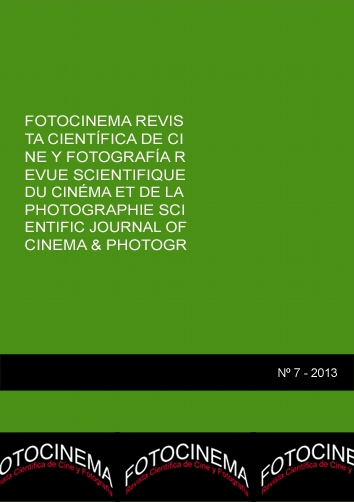Segundo de Chomón, un guía turístico de cine.
DOI:
https://doi.org/10.24310/Fotocinema.2013.v0i7.5924Abstract
Desde sus orígenes el cine ha sido un poderoso creador de imaginarios sobre las culturas y los países del mundo. Por lo mismo, ha contribuido a configurar la imagen de España como destino turístico. Aunque los primeros documentales sobre España fueron filmados por camarógrafos extranjeros, muy pronto los operadores españoles empezaron a realizar sus propias películas, contribuyendo a conformar el imaginario fílmico nacional. Entre ellas destacan los documentales turísticos realizados para la firma Pathé por Segundo de Chomón, cuya habilidad narrativa y compositiva sientan las bases del género. Con ellos, sin obviar las expectativas espectatoriales, el cineasta consigue aportar un plus de realidad capaz de contrarrestar los habituales estereotipos sobre España manejados por el cine nacional e internacional coetáneos. Palabras clave: Cine primitivo español, imaginario turístico sobre España, documental turístico, Segundo de Chomón.Abstract
Cinema has been, from the beginning, a powerful creator of imaginary about the cultures and countries of the world. For this reason, it has helped shape the image of Spain as a tourist destination. Although the first documentary about Spain were filmed by foreign cameramen, Spanish operators soon began making his own movies, helping toshape thenational filmicimaginary. These include tourist documentaries made for the Pathé firm by Segundo de Chomón, whose narrative and compositional skills form the basis of documentary gender. With them, without forgetting spectatorial expectations, the filmmaker manages to provide an extra of veracity able to counteract the usual stereotypes about Spain handled by the national and international contemporary cinema.
Key Words: Spanish primitive cinema, tourist imaginary about Spain, tourist documentary, Segundo de Chomón.Downloads
Metrics
Downloads
Published
How to Cite
Issue
Section
License
All contents published in Fotocinema Revista científica de cine y fotografía are protected under the Creative Commons Attribution-NonCommercial-ShareAlike 4.0 International (CC BY-NC-SA 4.0) license. All about this license is available in the following link: <http://creativecommons.org/licenses/by-nc-sa/4.0>
Users can copy, use, redistribute, share and exhibit publicly as long as:
- The original source and authorship of the material are cited (Journal, Publisher and URL of the work).
- It is not used for comercial purposes.
- The existence of the license and its especifications are mentioned.
There are two sets of authors’ rights: moral and property rights. Moral rights are perpetual prerogatives, unrenounceable, not-transferable, unalienable, imprescriptible and inembargable. According to authors’ rights legislation, Fotocinema. Revista científica de cine y fotografía recognizes and respects authors moral rights, as well as the ownership of property rights, which will be transferred to University of Malaga in open access. The property rights are referred to the benefits that are gained by the use or the dissemination of works. Fotocinema. Revista científica de cine y fotografía is published in an open access form and it is exclusively licenced by any means for doing or authorising distribution, dissemination, reproduction, , adaptation, translation or arrangement of works.
Authors are responsable for obtaining the necessary permission to use copyrighted images.













13.png)




